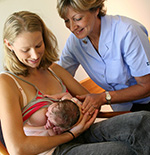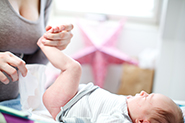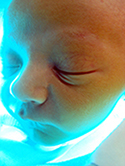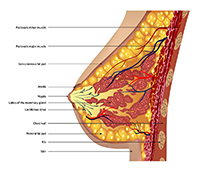Caring for your new baby
During your hospital stay, your midwives and others members of your Maternity Services Team will care for you and advise and assist you with the practical aspects of caring for your baby. This chapter contains a combination of general written information and videos to demonstrate the various aspects of caring for your newborn baby.
Breastfeeding

The World Health Organization (WHO) and leading Australian health experts recommend early initiation and exclusive breastfeeding up to 6 months for all infants, with the introduction of solid foods at around six months and continued breastfeeding until the age of 12 months or longer. Early initiation of breastfeeding is where the infant receives colostrum or is breastfed within the first hour of birth. Exclusive breastfeeding is the gold standard of infant nutrition, defined as the infant being fed breast milk only (including expressed breast milk, oral rehydration solutions, drops, syrups, vitamins, minerals, and medicines, as indicated medically).
Breasts are essentially milk secreting glands composed of fatty tissue, milk producing and storage glands and connective tissue. They are arranged in sections called lobes which consist of smaller pockets called alveoli. The alveoli are connected to ducts which carry milk to the nipple.
During pregnancy the pregnancy hormones oestrogen and progesterone cause your breasts to increase in size. Breasts may be prepared to produce milk as early as 16-20 weeks of pregnancy. Following childbirth milk production increases in the breasts when the brain releases the hormone prolactin. Immediately after birth your breasts will be soft and after a few days your breasts will begin to make milk. This is often called your milk ‘coming in’, and your breasts may feel warm, full and tender.
Although there is variation among individual women, the amount of milk produced by the breasts depends on early initiation and the frequency of feeds. Although the volume of milk produced may initially seem small, this will gradually increase over the first few days. Your breasts may secrete anywhere between 7-123 mls of colostrum per day in the first few days following birth and the amount gradually increases as the milk comes in around day 3-4. By day 5 your breasts can be producing between 500-800 mls of milk per day. Milk is produced and stored in the alveoli. Mothers continue to make milk between feedings and they make more milk during feedings. The other important hormone of breastfeeding, called oxytocin, acts on the breast to produce the "let down" reflex to release milk from the breast. Mothers may feel a sensation of pins and needles, pressure, or pain in the breast with “let-down”.
It takes several minutes of the baby sucking at the breast to cause prolactin secretion and during continued lactation; milk production is based on infant demand. However, the average mother's ability to produce milk is much greater than the average infant's appetite. The rate of milk production varies over the day. If a breast is not well drained at the end of the feeding, that breast produces less milk prior to the next feeding than it would have if the breast had been well drained. Suckling or any nipple or breast manipulation stimulates sensory nerves in the areola and nipple. These nerves stimulate the mother’s brain to release oxytocin and prolactin.
Breast milk is species-specific and biologically compatible, that is, it was designed for human babies. Its composition changes during the course of a feed and according to baby’s developmental needs over time. It contains all the nutrition and hydration a baby needs for the first six months of life. It has been shown to protect baby against illnesses such as respiratory infections, asthma, tummy bugs and allergies. There is also some evidence to support its role in reducing rates of obesity, high blood pressure, diabetes and heart disease in childhood.
Colostrum, or the first milk, is the thick, yellowish milk that is secreted by a woman's breast in the first few days after childbirth. It has increased concentrations of nutrition and antibodies. Due to its high concentration of antibodies, this milk is particularly valuable for infants in promoting healthy immunity and preventing infection. And in addition to it being cheaper and available whenever it’s needed, mothers may also benefit from breast feeding in other ways - by a more rapid recovery from childbirth, a closer bond with their baby, and by potentially increasing postnatal weight loss and lowering rates of breast and ovarian cancers and arthritis in later life.
Back to Top
Breast feeding assistance

Breast feeding does not always come naturally. It is generally accepted that with assistance in the techniques of breastfeeding, at least 97% of women can successfully breastfeed their infants.
You can increases your changes of successfully breast feeding through:
- Having the intention and the desire to breastfeed your baby
- Learning about the benefits and how to manage breast feeding
- Skin to skin contact with your baby at birth
- Initiating breast feeding within 1 hour of birth. Babies have a waking period for a couple of hours following birth where they are at their most alert and more likely to suckle at the breast
- Practicing rooming-in with your baby 24 hours a day
- Breast feeding your baby on demand (babies may feed 8-12 times per day)
- Avoiding giving your baby any artificial nipples, teats, pacifiers or breast milk substitutes (unless medically indicated)
- Learning how to maintain lactation even if separated from your baby. For example, expressing and storing breast milk
- Seeking and receiving consistent information, advice, support and encouragement for breast feeding in hospital and at home
- Ensuring your workplace is supportive of breast feeding
- Getting involved with breast feeding support groups in the community
- Accessing support and information from our hospitals that align with the Baby Friendly Hospital Initiative (BFHI)
There are some factors that are known to be associated with difficulty in starting and maintaining breast feeding. These include:
- Pain relieving medications such as opiates as well as the substances released by the brain during stress can block the release of oxytocin and the “let-down” reflex. For more information about the let-down reflex, refer to Hormones, breast development and milk production in the section Breastfeeding.
- Having a premature or unwell baby that is either unable to suckle at the breast, or mother and baby are separated when baby is cared for in a Special care Nursery or Intensive Care Nursery. Your midwives can assist you and support you to express milk for your baby and help you to maintain lactation until your baby is able to suckle at your breast.
- Emergency caesarean birth or other complications during birth, such as PPH (postpartum haemorrhage), where breast feeding initiation may be delayed because the mother is unwell or where her milk supply is reduced. Some of our hospitals are encouraging breastfeeding initiation in the Recover Room immediately following the caesarean birth now.
- Maternal smoking. Women who smoke are less likely to intend to breastfeed, less likely to initiate breastfeeding, and likely to breastfeed for a shorter duration than non-smokers
- Being overweight or obese. This is thought to be due to a lower level of prolactin causing decreased milk production
- Certain infectious diseases and some maternal medications or drugs that are not compatible with breast feeding (please see the link in the Resources for a list of these)
- Social and other personal reasons, such as younger age at first pregnancy, lower maternal educational status and early return to employment following childbirth
Back to Top
Formula or bottle feeding

If your baby is not breast feeding, the only other safe alternative is commercially produced formula. How you feed your baby is your informed choice and decision, and our midwives are there to advise, assist and support you if you decide to feed your baby with formula.
There are a few things you should know in order to prepare for this and ensure safe preparation, handling, feeding and storage of baby’s formula. Members of our Maternity Services Team will be able to advise and assist you with correct preparation and bottle feeding techniques during your hospital stay. In readiness, please bring your choice of formula and two bottles, with newborn/slow teats to the hospital and check with your hospital if you need to bring a steriliser for personal use. For more information about formula feeding please see the Resources.
If you are unable to or your informed choice is not to breast feed your baby, your breasts will still begin to produce milk. This may cause discomfort that lasts for a few days but very rarely, severe discomfort with breast engorgement may occur. Engorgement is the name given to breasts that become swollen hard and painful when the milk comes in. Sometimes the breasts can appear red and shiny and the mother may have a slight fever. Your midwife can advise you how to manage your breast care and may suggest some of the following ways to suppress lactation and reduce discomfort:
- Avoid excessive handling or application of heat to your breasts as this can stimulate milk production
- Wear a good, firm supportive bra day and night
- Use breast pads to soak up any leakage of milk and change them regularly
- Use cold compresses, gel packs or cabbage leaves worn inside your bra to relieve swelling and discomfort
- Take mild pain relief medication such as Panadol
- If your breast become engorged with milk, expressing small amounts of milk may help to ease discomfort but be aware that this can still stimulate your breasts to produce milk
- Do not restrict your fluids as this does not reduce milk production
- Talk with your obstetrician about other medications for lactation suppression but be aware that these can have undesirable side-effects
Back to Top
Changing nappies, bathing and wrapping your baby

Your midwife and other members of your Maternity Services Team will show you how to change nappies, bath and wrap your baby during your hospital stay.
Back to Top
Jaundice in your baby

About 6 in 10 newborn babies, and possibly more premature babies, will experience a condition called jaundice. Jaundice is a condition characterised by a yellowish discoloration in the baby’s skin and sometimes the whites of the eyes. It is caused by a substance excreted by the liver called bilirubin. Because a newborn baby’s liver takes a few days to process this, it can build up in the baby’s blood stream and appear in the skin and eyes. This is most often a natural process but sometimes can be caused by other conditions.
Back to Top
Immunisation and other testing for baby
Vitamin K is produced by our bodies to help the blood to clot and is essential to prevent serious bleeding. Worldwide Vitamin K is routinely given to babies at birth to prevent a rare, but often-fatal bleeding disorder called Haemorrhagic Disease of the Newborn (HDN). This disease can cause bleeding into the brain, which can result in brain damage.
Babies have very little vitamin K in their bodies at birth. Vitamin K does not cross the placenta to the developing baby, and the baby’s gut does not have any bacteria to make vitamin K before birth. After birth, there is little vitamin K in breast milk and breastfed babies can be low in vitamin K for several weeks until the normal gut bacteria start making it. Infant formula has added vitamin K, but even formula-fed babies have very low levels of vitamin K for several days. For this reason they need to be given extra until they build up their own supplies. Babies can get enough vitamin K to protect them for months from one injection.
Vitamin K has been used routinely in Australia for about 25 years and has almost eradicated HDN without apparent problems. As with any preventive measure, this is your choice. However, medical authorities in Australia are united in strongly recommending that babies be given vitamin K by injection. It can also be given in an oral preparation at birth, day 4 and again in 6 weeks. The absorption of this form of vitamin K is not as reliable. You will need to speak to your obstetrician well prior to delivery to organise this mode of administration. It will then need to be documented clearly on your antenatal card. A Paediatrician or midwife will give the injection of vitamin K just after birth. Vitamin K doses given to your baby are recorded in the baby’s Personal Health Record book.
Hepatitis B is a serious disease that can be contracted throughout life. It is caused by a virus that affects the liver. The Hepatitis B virus is found in infected body fluids including blood, saliva and semen. Hepatitis B can be prevented and the most effective way is by Hepatitis B immunisation.
Hepatitis B immunization is given to your baby with your consent. This vaccination can be safely given to babies shortly after birth and through infancy. It is given by injection during your hospital stay. Serious side effects of Hepatitis B vaccination are rare. The most common side effects are minor and disappear quickly. These include soreness at the injection site, mild fever and joint pain. Your baby may also be irritable for a short time. If you are concerned regarding your baby’s health after vaccination please consult your doctor.
This free test is recommended for all babies in Australia to screen your baby for some rare congenital disorders which may benefit from early intervention and treatment. Over thirty different congenital disorders can now be detected but some of the main disorders the test is checking for are congenital hypothyroidism, phenylketonuria, cystic fibrosis, galactosaemia and other disorders of protein and fat metabolism.
With parental consent the test is performed 48-72 hours after birth. A few drops of blood are taken from the baby’s heel and collected onto a special absorbent card. The dried sample is sent to the Newborn Screening Laboratory for testing. Early diagnosis means treatment can be started quickly, before the baby becomes sick. Your Paediatrician will contact you usually within the first 2 weeks of your baby’s life if there are any concerns with this test. Your obstetrician and midwives will be able to provide further explanation and answers to questions that arise during your stay.
About 1 to 2 in every 1000 babies has a hearing problem that requires treatment and support. State-wide Infant Screening Hearing Programs across Australia aim to make sure these babies are identified. This will usually occur whilst mother and baby are in hospital. The screen takes about 10 – 20 minutes and is done when your baby is asleep or resting quietly.
You can usually stay with your baby while the screen is being performed. Several small sensor pads are placed on the baby's head and soft clicking sounds are played into the baby's ear through an earphone. The sensor pads record the baby's responses to the sounds. Results are known immediately – a ‘Pass’ or ‘Refer’ result for each ear. These results will also be recorded in your baby’s Health Record book. A small number of babies require a second screening and if the result is to refer again, you will be invited to attend an assessment with an Audiologist (hearing specialist) at the earliest opportunity for more detailed testing to identify if a hearing loss is or is not present.
Back to Top
Your Baby’s Personal Health Record

After you have given birth you will be given your baby’s Personal Health Record book. It is designed for you and other health care professionals to record your child’s milestones, health, growth, development and immunisations throughout childhood. This book is to remain with your baby while in hospital so that our staff can record the immunisation information, hearing test and discharge weight in it. On discharge you will need to take this book home with you. Take this book with you each time you take your child to the Paediatrician, GP, hospital or other related services so they too can record details of your child’s health from birth to the teenage years. It also contains reminders about important ongoing health checks and immunisations as well as contact details for other family services.








